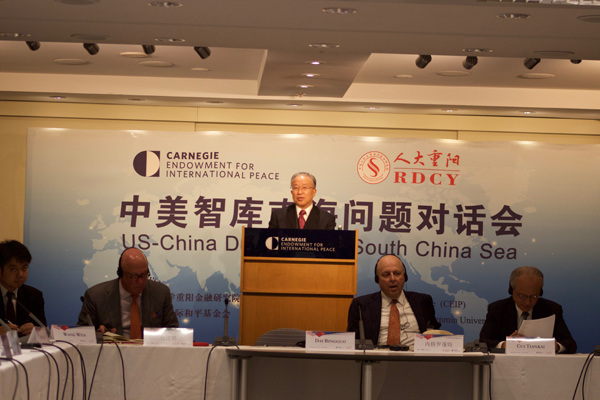The following is the full text of a speech delivered by former State councilor Dai Bingguo at China-U.S. Dialogue on South China Sea between Chinese and U.S. think tanks on Tuesday in Washington.

I am delighted to attend the China-U.S. dialogue on South China Sea between Chinese and U.S. think tanks jointly organized by the Carnegie Endowment for International Peace and Chongyang Institute for Financial Studies at Renmin University and meet with old and new friends. I would like to take this opportunity to thank both organizations for putting this dialogue together and my sincere thanks go to all of you here who have for long cared for and supported the development of China-U.S. relations.
I became honorary president of the Institute of International and Strategic Studies at Peking University after retiring from government. In this sense, I can also be counted as a think tank scholar. I very much look forward to having candid and in-depth exchanges with all of you for mutual enlightenment.
Since the door of communication between China and the U.S. opened more than 40 years ago, China-U.S. relations have come a long way despite twists and turns and produced tremendous and extraordinary outcomes. This has not only benefited the people of China and the U.S.,but also the whole world. Fast growth of relations between these two major countries in a short span of 40 years can be described as nothing short of a miracle in the history of major-country relations.
Three years ago,in June 2013, President Xi Jinping and President Obama held a successful meeting in Annenberg, Sunnylands. Since then,guided by the strategic consensus of no conflict, no confrontation, mutual respect and win-win cooperation,the two countries have continued to make important progress in the building of a new model of major country relations. China and the U.S. have joined hands in promoting progress in a wide range of fields in bilateral relations and addressing major issues bearing on mankind's future and destiny. Their trade volume and two-way investment have both scaled new heights. The two countries have stepped up macro-economic coordination which effectively facilitated world economic recovery and growth. China and the U.S. have signed 3 joint statements on climate change, playing a crucial leading role for reaching the Paris Agreement on climate change. The two sides continued to broaden practical cooperation in military-to-military, law-enforcement, energy, and cultural and people-to-people exchanges. They have conducted close coordination and cooperation on international and regional hotspot issues and major global issues such as Iranian nuclear issue, Korean nuclear issue, Syria, Afghanistan, peacekeeping, international development and global public health. Such cooperation has benefited both countries, and bolstered international confidence in the continued growth of China-U.S. relations.
China and the U.S. are two major countries with very different histories,cultures,social systems and values and at different levels of development. As such, it is only natural that they would encounter differences and challenges in their relations. What's important is to increase strategic communication in a candid way and handle and manage differences in a constructive manner. Furthermore, we should endeavor to transcend differences by focusing on and expanding cooperation. The South China Sea could well have been an example of this approach.
For a period of time, the South China Sea which used to be a rather quiet place has become not so quiet. The situation there has heated up to a quite unusual degree,drawing extensive international attention. What has really happened there? I noticed that reports and comments on this issue tend to take a static view from a certain angle, and thus have not shown the full picture of the South China Sea issue. In my view, to study an international hotspot issue, it is necessary to seek truth from facts by fully considering the relevant international background, tracing the historical development, and thoroughly reviewing how the concerned parties have interacted on this issue. Only in this way can one see the whole picture, tell right from wrong and draw the right conclusion. In this vein, I would like to focus my speech on the historical facts of the South China Sea issue and China's policy on this issue. And I will endeavor to view and handle the South China Sea issue from the perspective of China-U.S. relations and explore ways to genuinely cool down this issue and restore calm to this part of the world.
1. Nansha Islands are China's Integral Territory
Historical materials of China and many western countries corroborate the fact that it was the Chinese people who were the first to discover, name,develop and administer the islands in South China Sea, and that the Chinese government was the first to peacefully and effectively exercise continuous sovereign jurisdiction on South China Sea islands. During the Second World War, Japan illegally invaded and occupied China's South China Sea islands, which were restored to China after the war. Pursuant to Cairo Declaration and the Potsdam Proclamation,which were cornerstones of the post-war international order, Japan shall return the stolen Chinese territory to China. Following the end of the war, China restored Taiwan, Penghu Islands, Xisha Islands and Nansha Islands illegally occupied by Japan.
Many of you were probably not aware of this, but China's actions to restore the islands was supported by General Douglas McArthur. China's military and government personnel were ferried by U.S.-provided military vessels to Xisha and Nansha Islands to hold the restoration ceremony. After that, the U.S. filed applications to Chinese authorities on Taiwan to conduct geodetic survey in some of Nansha Islands on many occasions.


















































